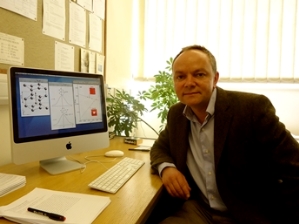

David E. Manolopoulos

Born December 14, 1961 in Gillingham, UK.
Professor of Theoretical Chemistry, University of Oxford, UK.
Email:david.manolopoulos@
chem.ox.ac.uk
WWW: external link
Fellow of the Royal Society (2011). Miller Visiting Professor, University of California at Berkeley (2012). Annual Prize of the International Academy of Quantum Molecular Science (2000). Royal Society of Chemistry Medals: Marlow (1995), Corday-Morgan (1997), Chemical Dynamics (2009).
Author of:
An Atlas of Fullerenes (with P.W.Fowler; Oxford University Press 1995, Dover Publications 2006), and numerous papers on chemical physics and theoretical chemistry.
Important Contributions:
- David Manolopoulos has made contributions to a wide variety of areas in theoretical chemistry. His spiral algorithm for generating carbon clusters underlies the IUPAC classification of fullerene isomers and has led to numerous experimentally-confirmed predictions of the structures and properties of higher fullerenes. The Atlas of Fullerenes that he wrote with Patrick Fowler in 1995 is now the standard reference for work in this field. His quantum mechanical calculations in chemical reaction dynamics have explained a number of important experimental results and led to an improved understanding of reactive transition states, the role of resonances in hydrogen atom transfer reactions, the statistical nature of insertion reactions that proceed via deep potential energy wells, the importance of electronically non-adiabatic effects in chemical reaction dynamics, and the effect of long-range forces on chemical reactions. The numerical methods and computer programs that he developed to perform these calculations are still widely used by the gas phase chemical reaction dynamics community and by those interested in cold and ultra-cold atomic and molecular collisions. His more recent work on condensed phase dynamics shows great promise for elucidating quantum mechanical effects in liquids and in light-atom transfer reactions in chemical and biochemical systems. His ring polymer molecular dynamics (RPMD) method is rapidly emerging as an effective tool for simulating a wide variety of processes ranging from polyatomic chemical reactions in the gas phase through the dynamics of liquid water and aqueous solutions to enzyme-catalysed hydride, proton, and proton-coupled electron transfer reactions.